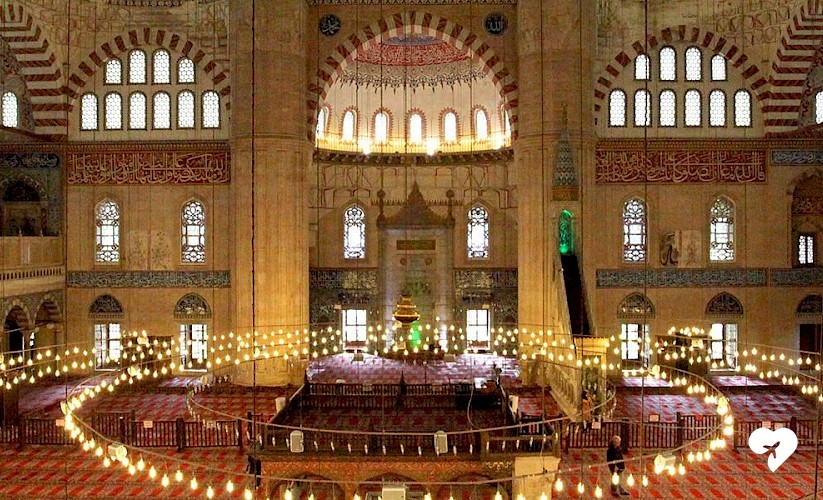Edirne was the capital city of Ottoman State before Istanbul and the Selimiye Mosque has been identified with the city. The mosque is a masterpiece of Mimar Sinan, the architect royal of Ottoman Court and he has been renowned as one of the most celebrated architects of the world. Sinan, the Architect, lived in the era when the Ottoman Empire was in its prime and he masterfully reflected the power of the Empire through his architecture. He put his mark on the zenith of Ottoman architecture. The mosque is one of the most significant structures of the Ottoman and world architecture. The status of the mosque is recognised by the world and the Selimiye Mosque and its Social Complex have been inscribed to the UNESCO World Heritage List.
The Masterpiece of Sinan, The Artchitect
The foundation stone of the magnificent Selimiye Mosque was laid in 1568, and approximately 15 thousand artists and artisans laboured until it was completed in 1575. While its magnificence is apparent from its exterior, the actual amazement is felt in the main hall of the mosque.
The domed main hall of Selimiye Mosque represents the summit of his architectural career. Despite the large diameter of the dome, the pillars bearing its load were not allowed to divide the central space. According to historical records, six thousand people were able to take part in Salat ritual in the main hall of the mosque during an encampment of Ottoman army marching on its way to European campaigns. The four minarets of the mosque were placed on the corners of the main hall, and each minaret bears three sherefes (adhan platforms). Those minarets are also very slender despite being quite tall and this in itself is an architectural wonder, and their design is considered to be one of the most elegant within the whole Islamic architecture. In two of those minarets, there are three internal staircases leading to different sherefes that do not intersect at any point. Sinan, the Architect, designated the mosque as "the masterpiece" of his architectural career, although he built several other world renowned magnificent structures. The compendium of his works, entitled Tezkiret-ül Bünyan (Book of Structures), noted that with the dome of the Selimiye Mosque he has surpassed the famous dome of Hagia Sophia basilica in Istanbul, and that its minarets were unmatched. Sinan, the Architect, was famous for his modesty as well as his genius and mastery, so referring Selimiye Mosque in such terms in a contemporary book that claimed reiterating his words, and calling the mosque as "his masterpiece" were proofs of his belief that he has employed all knowledge and skills he has amassed through his long career.
The Selimiye Mosque is worth a visit since besides its architecture, its Iznik glazed wall tiles; its painted decorations of geometrical and floral patterns and calligraphy by master artists; the carved and mother-of-pearl inlaid wood fixtures, the carved marble mihrab and minbar are masterpieces in their own rights. One of the structures that made up the social complex of the mosque, the Dar al-Qurra Madrasa, has been converted to serve as the Foundation Museum, and another structure, the Dar al- Hadith Madrasa, now houses the Museum of Turkish and Islamic Art.
.jpg)
Edirne: The City Adorned with Architectural Masterpieces
The Ottoman Sultans adorned principal cities and especially its capital cities with architectural masterpieces. Edirne served as the capital city for almost a century, so like the previous capital city Bursa and succeeding capital Istanbul, it was also adorned with magnificent structures in line with the tradition. Without doubt the most important of all those monuments is the Selimiye Mosque. However, there are other significant structures of Ottoman architecture that has marked the privileges of the city. Among them are Eski Cami (the Old Mosque), Üç Şerefeli Cami (the Mosque with Three Sherefes), II. Beyazıt Külliyesi (the Religious Complex of Sultan Beyazid II), Muradiye Camisi (Muradiye Mosque), Deveci Han (Caravanserai of Cameleers) , Rüstem Paşa Kervansarayı (Caravanserai endowed by Rustem Pasha, the Grand Vizier of Suleiman the Magnificent). Also Kanuni (Suleiman the Magnificent) Bridge, Tekgöz (Single Span) Bridge, Tunca (River Tundzha) Bridge, and Meriç (River Maritsa) Bridge are noteworthy structures. Nevertheless there are many mosques, religious complexes, madrasas, caravanserais, bridges, fountains, and other civic architecture dotting the city. As each and every one of those civic structures is noted as a significant example of Ottoman architecture, Edirne is also referred to as the "Museum City". So spare a few days for visiting Edirne if you wish to enjoy the Ottoman architectural heritage as well as the natural beauty of the city created by three rivers, Arda (Ardas), Tunca (Tundzha), and Meriç (Maritsa).
How to Go?
Edirne is two-hour drive away from Istanbul, the largest city of Turkey. After your flight to Istanbul, you could take a ride on any of the hourly departing coach services. There are also scheduled coach services from other cities. Edirne is also one of the major stations on the rail connection between Istanbul and European destinations.
